A list of animal characters found in Disney's Mickey Mouse Comic Universe.
Click here to return to the main list.
- Click here to go to the protagonist list.
- Click here to go to the friend list.
- Click here to go to the antagonist list.
- Click here to go to the fiend list.
- Click here to go to the otherworlder list.
- Click here to go to the subseries character list.
- Click here for more options.
Keep in mind that since the characters and series have been around for so long, whether a character displays certain traits or not in any given story largely depends on the artist, the writer, or the time period.
Main animals
Pluto the Pup note

Mickey's ever-faithful canine pal. Mickey's often described Pluto as his best friend, and the bond the two share is nothing short of strong.
- Big Friendly Dog: If he stands up on his hind legs he's easily taller than Mickey (though this isn't such a big feat), but he's a very sweet-natured and well-behaved dog.
- Canine Companion: To Mickey, of course. According to Mickey in "Pluto the Racer", he's a breed of hound dog and "practically pure-blooded". The former isn't contested, but most people who look at Pluto laugh at the second statement.
- Canines Primary, Felines Secondary: Pluto's the cause of this, being the highest-ranking animal character. Of course his peers are all dogs, while cats are relegated to the role of rival, villain, or target.
- Evil-Detecting Dog: Whenever Miklos is around, Pluto is the only one who can reliably tell them apart.
- Heroic Dog: In the 1995 story A Mouse and His Dog, Pluto saved Mickey from Princess Queezila of the underground troll kingdom.
- Huge Guy, Tiny Girl: Most of Pluto's love interest, the recurring ones included, are much smaller than Pluto, who himself is usually drawn as one of the larger dogs whenever he is in company. One of the few exceptions is an Old English Sheepdog in a 1954 gag comic.
- Interspecies Romance: Pluto fell in love with a cat in "The Cat's Meow". He also behaved as a cat during that time himself, seemingly to please her.
- The Speechless: On occasion he might be given thought bubbles that are visible only to the reader, and sometimes captions will appear to inform the reader of Pluto's thoughts and reasonings, but otherwise he doesn't have any means of clear communication.
- Suddenly Voiced: In a couple of stories, he temporarily gains the ability to talk. It never sticks.
- Played with in one comic, where Pluto was given the opportunity to talk to Mickey through a translation machine — and after a long pause his only message was that he couldn't think of anything to say.
- Suspiciously Similar Substitute: In some comics he stands in for General Snozzie as The Junior Woodchucks' official dog.
- Team Pet: He'll sometimes play this role.
Core animals
Fifi the Peke
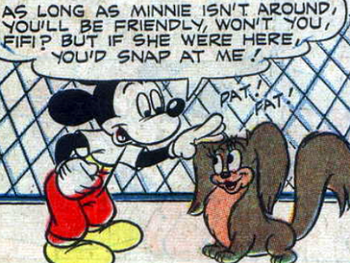
A Pekinese dog owned by Minnie and a love interest of Pluto.
- Canine Companion: To Minnie. As per "Happy Ending", Fifi is as protective of her as Pluto is of Mickey.
- Hidden Heart of Gold: Inverted. Fifi acts hostile towards Mickey whenever Minnie is around, but is a lot more accommodating when Minnie is away. Sometimes, like in "The Dog Show", it's a default, while in stories like "Westward Whoa!" the gentler nature comes from Mickey being able to stand his ground against her.
- Huge Guy, Tiny Girl: Fifi is really tiny comapred to Pluto.
- Mister Muffykins: With the focus on Minnie being the origin of the annoyance.
- Motivation on a Stick: It wasn't planned but still a circumstance Mickey gladly exploited. In "Westward Whoa!", Fifi got on the end of a branch and when Mickey tried to reach her, it broke off and the two landed atop a mountain lion in a position that left Fifi in the role of carrot. It allowed Mickey to use the mountain lion as mount.
- Out of Focus: Fifi disappeared for fifteen years between "Westward Whoa!" in 1953 and a 1968 gag comic. Not counting a photo comic of the short Pluto's Quin-puplets, she hasn't had an appearance since.
- Sudden Name Change: In her debut comic, Fifi was known as "Flapper". A 1968 gag comic renames her "Mimi" for unknown reasons.
- Suspiciously Similar Substitute: Fifi the Poodle is her main one, but there are also two gag comics in which a dog very similar to Fifi shows up that is owned by someone other than Minnie.
Butch the Bulldog

A bulldog who is a sometimes a rival to and sometimes a bully of Pluto.
- Arch-Enemy: To Pluto. There are two separate traditions, one in which Butch is Bully Bulldog and another in which he merely is The Rival and Protagonist-Centered Morality plays heavily into Pluto's narrative. In the former tradition, their conflicts are usually about bones. One 1954 comic even introduces Butch as "the bully bone-robber Butch". In the second tradition, the attention of a pretty girl more often is the prize.
- Depending on the Artist: In the classic shorts, Butch is depicted as having grey fur. For one reason or another, this became white in the comics. Sometimes, Butch would be brown (a look adopted by Mickey Mouse Clubhouse) and for a short time in the 90s he was white and brown. (English) Prints in which Butch is grey are remarkably rare.
- Enemy Mine: "Temporary Teamwork" brings Butch and Pluto together because it's the only way they have a chance against a mastiff named Toughie that's recently moved into the neighborhood.
- Friendly Enemy: To say Butch and Pluto are ever portrayed as friends is too much, but they do have pleasant moments where there's no reason to fight. Pluto even invited Butch to his birthday party in a 1957 comic.
- Would Hurt a Child: In The Purloined Pup, which was loosely adapted into a comic by the same name, Butch kidnaps a puppy for ransom. It is one of the few portrayals of him as an actual villain.
Dinah the Dachshund
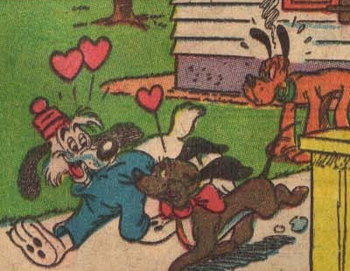
A dachshund who is a love interest of Pluto, Butch, and Boffo.
- Huge Guy, Tiny Girl: All of Dinah's suitors are about thrice her size.
- Love Redeems: In her debut comic, Dinah works for the dogcatcher and lures male dogs to him. Pluto gets trapped this way too, but Dinah genuinely likes him. When he snubs her for her trickery, she sets him and the other dogs free to amend. Pluto forgives her.
- Replacement Goldfish: Dinah took over from Fifi the Peke in the 40s. This is more obvious in the shorts, because Dinah only appeared in a handful of gag comics.
- Suspiciously Similar Substitute: Another dachshund in a 1950 gag comic in a plot that's very similar to Dinah's debut gag comic. Both were written by Bill Walsh. The difference between the two is that the substitute wears a flower above her right ear and didn't regret assisting the dogcatcher the way Dinah did.
Goofy's parrot
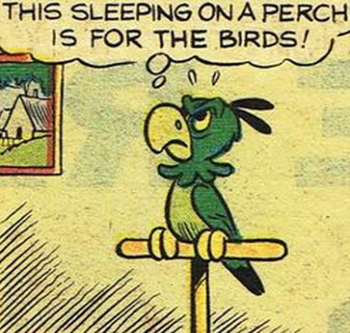
Goofy's parrot.
- Expy: To Ellsworth, who disappeared from the Sunday strips about six months before the parrot's debut. They are similar wisecrackers, but the parrot does not dabble in Furry Confusion like his predecessor.
- No Name Given: In English, anyway. He's got a name in some other countries, like "Lorre" in Dutch and "Pelle" in Norwegian. These are standard parrot names on par with "Polly" in English.
- Polly Wants a Microphone: He's a talking parrot, and a rather demanding one too. He has combined it thrice with Ventriloquism to trick Goofy into putting Tiger outside.
- Stock Animal Diet: It wavers between averted and played straight. Sometimes, his priorities are crackers and the stuff's even good enough to invite a girlfriend over for. Other times, he vocally complains that he deserves better, like pizza.
Tiger the Cat

Goofy's striped cat.
- Arch-Enemy: Goofy's parrot, although the hostility originates on Tiger's side.
- Cats Are Mean: Tiger always tries to eat the parrot, once stole a fish Goofy'd just caught, and scratches whatever furniture to pieces with no regrets. One comic had Goofy putting the cat outside and tell him to use a tree for scratching instead. It destroyed the base of the tree so badly it fell — right on Goofy's house.
- Cats Hate Water: The parrot twice acquired a water gun to defend himself against the cat with.
- Shout-Out: With its striped fur, regular orange coloring, and selfish bordering on belligerent personality, not to mention placement in a newspaper strip, there's a good chance Heathcliff, who debuted in 1973, was the inspiration for Tiger.
Notable animals
Spooks the Gorilla

A gorilla associated with Captain Churchmouse. He was previously known as Bombo.
- Attack Animal: Overlaps with Killer Gorilla from the baddies' perspective. Not only is Spooks very protective of his friends and smart enough to understand instructions, he's also good at forming friendships with any local simian population and getting it to back him up in battle.
- Expy: The gorilla Spook in "On Spook's Island" is one of Spooks. The 2007 reprint even renames him Spooks. The two are not the same, though, because Spook and Spooks have different backstories and the Bill Wright comics (writer unknown) are written to fit Gottfredson-Walsh canon.
- Fire-Forged Friends: Mickey and Spooks met when Mickey did not know he was aboard the "Pot Luck" and half-wondered if the ship was haunted. It wasn't a good start and things turned even uglier when Shyster and Pete abandoned the two in a lifeboat. Spooks's first attack caused the boat to turn, calming its aggression towards Mickey, although Mickey didn't let him back in until sharks approached. It was at this time Mickey gave him the name "Spooks". Some hours later, the lifeboat got caught in a storm and Mickey got stuck with a seasick, crying gorilla. They survived by reaching an island and Spooks was friendly towards the mouse from then on.
- Meaningful Rename: Spooks's original name was "Bombo". After Captain Churchmouse's disappearance, Bombo remained in hiding on the abandoned "Pot Luck" not to be seen by anyone until the ship set sail once more years later. No one aboard the "Pot Luck" knew Bombo's history, let alone that he had a name, so Mickey named him "Spooks". When Captain Churchmouse was found and could tell the gorilla's story, he at first called him "Bombo", but then accepted the new name when he realized it'd been fifteen years since the name "Bombo" was used last.
- Mysterious Animal Senses: In "In Search of Jungle Treasure", Spooks is revealed to be a homing ape, which gives him the ability to find his way back to his birth grounds no matter how long he's been away. It was for this skill he was captured as a baby by Captain Hazzard, as Hazzard needed a means to one day find his way back to the treasure he had to leave behind. The hardships were too much for him, but decades later Mickey and his did retrieve the treasure thanks to Spooks.
Terry the Pup
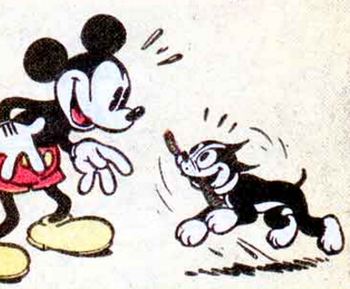
A Boston bull terrier who lives in Pluto's neighborhood.
- The Bus Came Back: In 2001, Terry was among the dogs picked for a cameo when Horace tried to break the world record walking the most dogs simultaneously in "World's Greatest Horace". He'd not been seen since 1939, 62 years ago.
- Bratty Half-Pint: In "Pluto's Rival", Terry causes nothing but trouble for Pluto and although not intentional, he also doesn't mind Pluto getting the blame.
- Children Are Innocent: In puppy form. It's how he came to be owned by the dogcatcher in "Pluto's Rival", by following the man just after Pluto and Mickey saved him. It turned out for the better because the dogcatcher always wanted a dog but couldn't afford the license, so Mickey gifted it him.
- Kid Sidekick: Strongly in the short Just Dogs, but present too in "Pluto's Rival" and "What a Boner". Terry looks up to Pluto and wants to be acknowledged by him, but Pluto's not feeling it. As per his Jerk with a Heart of Gold tendencies, Pluto usually warms up to him after they've been through the necessary trouble. If not, then he learns that Terry can be a Pintsized Powerhouse.
Tanglefoot

Mickey's horse, sold to him by two con men who presented him as a champion race horse (they'd actually bought him from the glue factory). Sweet and good-natured, but not terribly bright, and for the most part not terribly fast — unless he gets scared of something, then he turns into a speed demon.
- The Alleged Steed: Slow of body (unless he gets startled, in which case he runs at a breakneck speed and is near-impossible to steer), slow of mind, rather clumsy, not very good at understanding or obeying commands, and tends to get distracted and wander off when he's supposed to stay put.
- Friend to All Living Things: Tanglefoot's most notable quality is that he's the kindest horse ever. This, unfortunately, also makes it impossible to let him out of sight because he's got no ability to make negative judgements. In "Tanglefoot Pulls His Weight", Mickey worked as a horse-and-cart milkman for a bit, but when left unattended, Tanglefoot would give away milk to hungry kittens and anyone who looked like they were thirsty or gave him some attention. Many people petted him for the sole purpose of receiving free milk.
- Horsing Around: Happens at times. For the most part, though, Mickey and Tanglefoot get along pretty well.
- Stalker with a Crush: Probably not in a romantic way, but Tanglefoot adores Pluto and will follow him around if given half a chance. Pluto, needless to say, does not appreciate this.
Sluggy the Cat

A tough street cat who regularly gets into trouble with Pluto and Ellsworth.
- Cats Are Mean: At least when not being chased by Pluto. Very much the focus of his debut comic with things getting so out of hand that the city decides to put him down despite Mickey's offers to pay for the damages. A convenient fire outbreak in the pound gives Sluggy a chance to prove himself by waking the dogcatcher, after which the death penalty is off the table.
- Depending on the Artist: Fluffy's been colored in ever color not too peculiar for a cat by now. Medium grey is his original and most recurring color, though not by much.
- Family Man: As per "The Fiendish Cat", Sluggy may have up to 54 kittens.
- Mistaken Identity: In a 1949 gag comic, Sluggy and Pluto get covered in foam during a chase and mistake each other for themselves, continuing the chase in reversed roles. Only after the foam's rolled off and they see themselves in a store's windows do they realize the mixup.
Dagmar the Police Dog
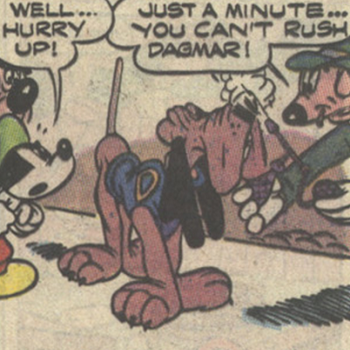
A police bloodhound.
- The Bus Came Back: In 2001, Dagmar was among the dogs picked for a cameo when Horace tried to break the world record walking the most dogs simultaneously in "World's Greatest Horace".
- Plot Allergy: Dagmar is brought in to find Eega Beeva, who has gone missing. The only thing Mickey has left to take his scent from is a kumquat. Take a guess what Dagmar just so happens to be allergic to.
- World's Best Warrior: Dagmar is considered the "greatest bloodhound in the business".
Fifi the Poodle

A poodle owned by Minnie and a love interest of Pluto and Butch.
- Damsel out of Distress: Played with. Fifi is pestered by a crow that has taken up residence in Mickey's garden. Pluto tries to win her affection by dealing with the bird for her, but he fails twice. Then he comes up with a plan to catch the crow by surprise, but he needs Fifi's help to pull it off. Fifi has no hesitations about it and plays her part well.
- Huge Guy, Tiny Girl: Fifi's bigger than most of Pluto's love interests, but she's still significantly smaller than he is.
- Rescue Romance: With a dose of Fire-Forged Friends. Fifi thought Pluto had charm from the start, but she didn't favor him over Butch until they beat the crow bothering her together.
- Suspiciously Similar Substitute: Of Fifi the Peke, a dog Minnie usually is depicted to own. All three of her appearances are in Christensen-Murry comics, two in 1953 and one in 1954. It's unclear if You Don't Look Like You is at play or if she's meant to be a separate character. Despite the overlap, Murry drew Fifi the Peke in "Westward Whoa!", inbetween the last two Fifi the Poodle stories. Even more confusing, in Fifi the Poodle's final story, she's not namedropped, but another dog seemingly modeled after Dinah the Dachshund is named Fifi. Of further note is that the 2015 print of "Caws and Effect" from which the image is taken blurs the line between the dogs more than the original by depicting Fifi in browns, when the 1950s had her in dark grey.
Tuffy the Cat

A black-and-white cat who is friends with Scrags.
- Butt-Monkey: Whenever Pluto's the protagonist of a comic she appears in, and in his absence others will take over to go after Tuffy, such as the eagle Swifty in "Uncle Gudger" and Boo-Boo in "Pluto in Love Trouble".
- Cats Are Mean: When Pluto is not part of the story, Tuffy tends to be portrayed as meaner and deserving of what punishment she gets.
- Depending on the Artist: Tuffy sometimes has a white tip on the end of her tail and sometimes she doesn't.
- The Dividual: Forms type Syndividual with Scrags when Scrags is featured.
- Friendly Enemy: Tuffy and Pluto usually don't get along due to Pluto's hostility, but there are times they've come to each other's aid. In a 1954 comic, Tuffy saves Pluto from the dogcatcher, while Pluto after bullying Tuffy in a 1955 comic had the decency to take care of her kittens until she returned for them.
- Out of Focus: Hasn't been in a comic since 1974.
Scrags

An orange, striped cat who is friends with Tuffy.
- Cats Are Mean: Scrags shows up alongside Tuffy and rarely in comics featuring Pluto too. As such, the same portrayal of mean and deserving of punishment as goes for Tuffy goes for Scrags.
- The Dividual: Forms type Syndividual with Tuffy.
- Out of Focus: Hasn't been in a comic since 1974.
Agenore
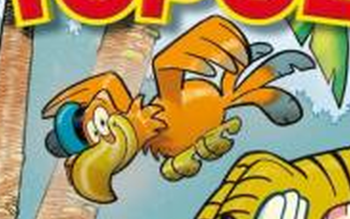
Jeremy's parrot he acquired in China. It accompanies him wherever he goes.
- Accessory-Wearing Cartoon Animal: Agenore wears a blue sailor cap.
- Pirate Parrot: Agenore is Jeremy's parrot and Jeremy is not a pirate, but he is a sailor with moral flexibility relative to the profit.
Other animals
Bobo the Elephant

A baby elephant originally purchased by Eli Squinch that through circumstances came into Mickey's possession. It was finally reunited with its mother and sold to the circus she's part of.
- Accidental Bid: This is how Mickey acquired Bobo, after it was sent to the wrong town and its documents went missing. The price he paid for the "mystery crate" was three dollars and thirty cents.
- Heartwarming Orphan: Bobo might be an animal and technically not an orphan, but there's no escaping it's a baby without its parents (until the final pages) and no good place to go to (until the final pages). Squinch can easily be regarded as The Fagin in this scenario.
- The Prankster: It loves to cause mischief, its first targets being Pluto and Horace. Horace kinda deserved it because he claimed elephants have no sense of humor. On the other hand, Bob didn't like it at all to be repeatedly targeted by Goofy with pepper-filled candy and sabotage of his instruments and never forgave him for it either.
- Powered by a Forsaken Child: A non-fantastic version but one that pulls the same strings. Squinch needs Bobo to power sawmill plant cheaply. He's prior worked several horses to death that way and he was hoping an elephant would last a good while longer. He didn't expect to be sent a youngling, noting it might not be able to meet the demands of the work either, but that wasn't stopping him from wanting to give it a try anyway.
- Ridiculously Cute Critter: Between its large eyes, signature "garfle" sound, and perpetual upbeat disposition, not a panel goes by in which Bobo isn't adorable.
Zowie
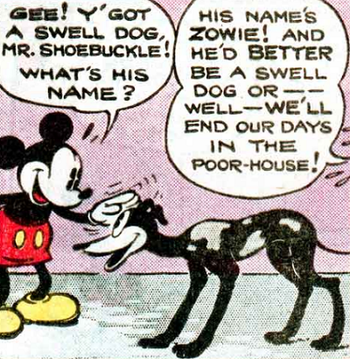
The Shoebuckle's dog and the fastest canine in Mouseton and its surroundings. He's a friend of Pluto.
- Epic Race: The premise of "Pluto the Racer". Zowie was certain to win, Black Lightning was certain to be second, and Pluto was certain not to be allowed to run at all. After some arrangements by Black Lightning's owner, Zowie failed to compete, Pluto won in his stead, and Black Lightning got second.
- Fixing the Game: Zowie was put on the receiving end of this. At first Mickey, his trainer, was asked to not enter Zowie in return for arranging Pluto's entry in the race (he'd been banned earlier and Mickey wanted him to get a chance to prove himself). Mickey refused and so the "Opposing Sports Team" sneaked Zowie a laced biscuit. He'd recover eventually, but not in time for the race.
- Hard Work Hardly Works: Zowie is introduced when he's already set to win the big race and his training only is to keep him in shape, as well as a way to get around Pluto's ban because he is allowed to use the track for practice as Zowie's training buddy. Pluto later has to use the training he got alongside Zowie to win for him.
Oscar the Ostrich
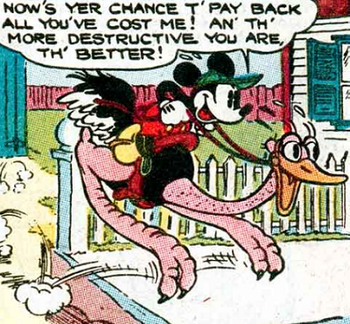
Officially named Giovanni, Mickey came to temporarily own the ostrich shortly after he escaped his owner, Tony Dinero. Tony was just in the process of ridding himself of the destructive ostrich by sending him to one "Oscar". Mickey saw the name on the label and went with as the ostrich's name.
Agnes the Lion
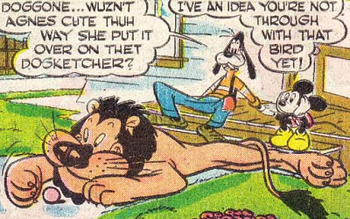
A lion Goofy bought from the circus and later sold her and her cubs to another when it was in her best interest.
- Bestiality Is Depraved: The whole setup to Agnes's introduction is that Mickey thinks Goofy's got a new girlfriend... who so happens to eat hamburger at twenty pounds at a time. Even after the punchline has arrived, the humor stays on Goofy talking about Agnes as if she's "more" than a pet for about a third of the story. For starters, he named Agnes after an Agnes he once courted and claims the two share the same wavy hair and dreamy eyes. His exaggerated story of how he acquired her (he really just bought her for a fiver) is of the "Dastardly Whiplash threatened The Ingenue, so I stepped in" variety.
- Big Eater: Not exceptionally so for a lion, but Goofy didn't account for the food bill when he took her in. It's that bill that became a strong argument in accepting that she needed a different home.
- Cowardly Lion: A literal case. Regular dogs are enough to scare her up a tree as if she was a regular housecat.
- Cute Kitten: For all that the humor leans on Goofy having a lion of all possible animals as pet, it's 100% dedicated to showing her off as as cute as Goofy sees her.
- Fire-Forged Friends: At first, Mickey is the most vocal character in the story insisting that Goofy gets rid of Agnes. As events unfold, he comes to agree with Goofy that Agnes is harmless and grows distasteful of the neighborhood's and city council's attempts to remove the animal with no regard for its well-being.
- Loophole Abuse:
- The reason Goofy manages to keep Agnes for most of the story is that there's no specific law against keeping a lion. Amazingly, Goofy himself challenged the city council to show him such a law or leave Agnes alone.
- When the city council DO vote for a law that bane lions, Agnes is revealed to be female and has cubs. After talking with their lawyers, the city council has no other choice but to go back to the drawing board, which will take place in another session, 1 month later.
- Sweet Polly Oliver: Agnes doesn't actually have a mane. It's a tight wig given to her by the circus to make her look more fierce. Goofy didn't figure this out until shortly before she had cubs, but then again, he always thought of her as female anyway.
King Silver
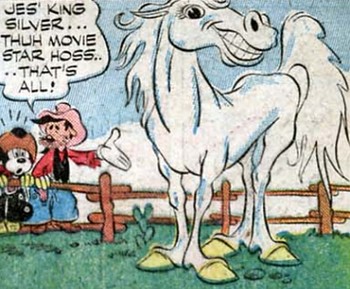
A movie star horse that came into Mickey's possession when he pretended to be Billy the Mouse. Billy's saved the life of a horse thief, Jake, four years prior and King Silver was his means of thanking Billy for that.
- Attention Whore: Having a history of being in the spotlight, King Silver will do anything to get the camera on him. First thing he does when Mickey gets on is photobomb a picture a mother tries to take of her son. King Silver's peculiarity does come in handy when Mickey has to rob a train. The horse is a Lovable Coward, but simply being told "Lights, Camera, Action!" as if his big scene is going to be recorded is enough to get him to perform the most daring of acts.
- Eternally Pearly-White Teeth: King Silver's almost perpetually smiling with bared teeth to look good whenever.
- White Stallion: A parody with some fluctuation to it. The fluctuation is due to that not all color versions of "Billy the Mouse" choose to make King Silver white; the first American color print even starts all white, then switches to brown halfway. Based on the name, the intent does seem for King Silver to be (near) white. The parody is on account that King Silver likely owes his movie career to the trope as applied through Show Within a Show, but within the comic story's reality, although he gets to be Mickey's horse, he's such a handful that he barely qualifies.
Boffo

A former circus dog that was taken in by Pluto.
- Appropriate Animal Attire: He wears a sweater and a cap.
- Circus Brat: An animal version. Boffo loves to perform and shows off for Pluto right after the latter has got him fixed up. Unfortunately for Pluto, Boffo didn't just make him laugh, but Dinah too.
- Getting the Boot: Pluto met Boffo when his owner literally kicked him out of their camper for being too old.
Jocko and Jockette
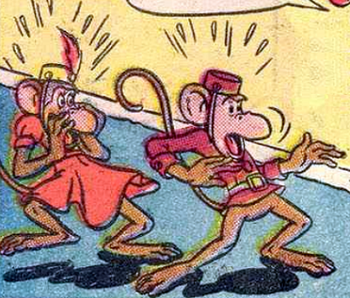
Two monkeys that belong to Morty and Ferdie. Jocko used to be owned by Tony, the organ grinder, until he retired. Jockette's origins are unknown because she came home with Jocko one day. However, she must have a similar history as a performer.
- Destructive Savior: Jocko and Jockette only mean well, but one way or another everything they do turns out disastrous. The very reason Jocko went out to look for a companion was because Morty and Ferdie were fighting over him, so with two monkeys they wouldn't have to fight. Clever and precious, but Mickey wanted to get rid of Jocko to begin with. To get in Mickey's good graces, the monkeys make him a delicious meal. Mickey is satisfied, but only until he learns they used his prize plants as ingredients. When a mob sets its sights on Mickey for damage the monkeys have caused, they come to his defense by pelting the mob with fruit, which makes things that much more worse. And to help Mickey pay for the damages, they go back to their old skill at performing for money, only for Mickey to furiously point out they aren't operating under a license anymore and can cause him to be arrested for begging.
- The Food Poisoning Incident: The two monkeys get their hands on perfumed soap while unsupervised for a second. They eat it. Mickey immediately has the doctor come to save them and while they live, he's stuck with a bill of $50.
- Heroic Fire Rescue: Mickey is deadset on getting rid of the monkeys after they've caused him nothing but trouble, bills, and an encounter with the law, even if he understands they never meant any harm. At night he forgets to lock their cage, which becomes a fortunate oversight when the two wake him in the middle of the night to point out the house is on fire. The stairs are aflame, cutting off the escape, so Jocko and Jockette grab a nephew each and help them through the window via nearby tree safely to the ground below. After this, Mickey decides to keep them. (How Mickey himself got outside isn't covered by the story.)
- Organ Grinder: Jocko used to be the money collector for and organ grinder named Tony. When Tony retired and couldn't take Jocko to live with his son, he gave him to Morty and Ferdie. Jockette might be an organ grinder's monkey too because her skills and behavior are similar to Jocko, but nothing is confirmed.
Umbrage and Magnolia

A college-educated gorilla that was the pet and colleague of Maxwell Mouse. He lived with Mickey for a time thereafter, during which he and Magnolia, a zoo gorilla, met. They went out on their own once they got married.
- Beast and Beauty: Inverted. The female half still is the beauty and the male half still the "beast", but from a gorilla perspective. Magnolia affects Umbrage's self-image, even causing him to temporarily give up human society in frustration, until the two of them find a balance that works.
- Control Freak: Umbrage has particular ideas of class, manners, and finesse his environment better adheres too. It got worst during his short but explosive career as director, multi-script writer, and studio vice president.
- Expy: Umbrage is none too subtly a character-upped version of the unnamed gorilla Eega Beeva hired to keep his research secret in "The Atombrella and the Rhyming Man". With a bit of stretching, it's even possible to interpret the two as the same gorilla and that it was Umbrage's prior dealings with Mickey that caused him to be selected as his new caretaker.
- Friend to All Children: As much as Umbrage exclusively embraces classy activities, he has a soft spot for children and enjoys playing with them. Unfortunately, the parents tend to not be charmed by the thought of them hanging out with a gorilla.
- Love Triangle: Magnolia liked both Umbrage and Magnifico and they liked her back. Eventually, the two males got into a fight that Umbrage won. This certainly impressed Magnolia, but Umbrage was done with her by then, even if it left him frustrated and heartbroken.
- Rescue Romance: Their potential romance apparently definitely over, fate turned things around when a fire broke out in the zoo and Umbrage had to rescue Magnolia. The two married shortly after and left for Africa on honeymoon.
- Stern Teacher: With some elements of Badass Teacher. Umbrage is a firm believer of the right to and need of education and will give up his free time to make sure whoever has proven themselves uneducated will be up to scratch.
- Tsundere: Magnolia met Umbrage when he visited the zoological gardens she was kept at. She made eyes at him, but he didn't even notice her. So she threw her food bowl at him. Then he noticed her. At first this seemed to satisfy her, but right after he gave her flowers she drenched him with a bucket of water and she loudly mocked him for his poetry composed just for her. Umbrage persisted, though, and she did grow stable feelings towards him... until Magnifico joined the zoo's gorilla population.
- Uplifted Animal: Umbrage in particular but Magnolia is certainly not to be excluded. No special reason is ever given — they've just been educated and although they still are animals they get a lot of room to interact in human business. Because there's no special reason they have their intelligence, they cannot talk but they can read and write.
Ezra the Alligator
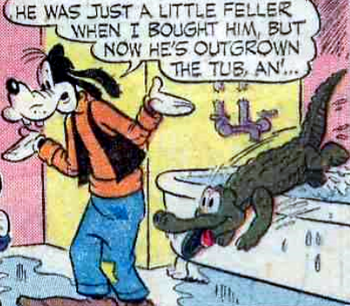
An alligator Goofy bought when it was little.
- All Animals Are Dogs: Lightly, but Goofy does walk him on a leash and he has his tongue hanging out in some panels.
- Bad People Abuse Animals: It's implied the crook would've killed Ezra if Mickey and Goofy hadn't disarmed him timely.
- Hiccup Hijinks: After swallowing a stolen bag of money, Ezra continuously hiccups up banknotes. In the end, the bank buys him and gives him a job as assistant cashier until he's hiccuped up all the money.
- Never Smile at a Crocodile: Ezra's of the cuddly variety, but he does try to bite things whenever he can. It becomes a plot point when he swallows the bag of money a crook just stole from the bank.
Tiger the Pup
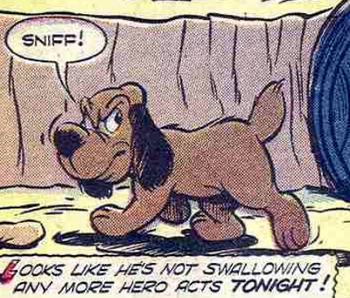
A puppy owned by Minnie.
- Broken Pedestal: Tiger is immediately impressed with Pluto when Minnie leaves the older dog to babysit him. Then he accidentally scares Pluto with his yapping and the impression falls apart. Rebuilt Pedestal kicks in when Pluto saves him from falling to his death.
- Sleep Cute: After their ordeal, Pluto and Tiger are brought home by police officers. Pluto is already fast asleep when they arrive, while Tiger is still full of energy. The pup nonetheless decides to cuddle up to his protector as they wait for Mickey and Minnie to come home.
- Straying Baby: Once he stops admiring Pluto, he goes out on his own, stealing Butch's bone, rushing into traffic, and getting himself launched upwards at a construction site to end up dangling from a rope by his teeth.
Boo-Boo the Pekinese
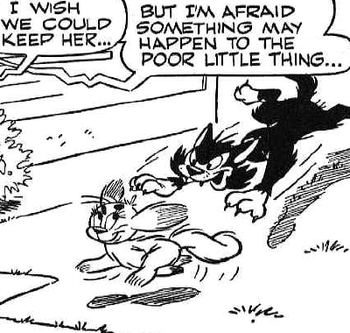
A Pekinese dog that belongs to Mademoiselle Clou-Clou, owner of the Bon-Bon Bonnet Shoppe.
- Bitch in Sheep's Clothing: Overlaps with Killer Rabbit. Boo-Boo is a selfish, violent, and vain monstrosity that within days becomes the terror of the neighborhood. She uses her cutesy looks to lure cats into attacking her so she can attack them, dragging her defeated opponents to the back of the yard where she scratches her score in the fence. She can gnaw through the tires of a moving car in an instant. And the dogcatcher only was way too happy handing her back to Mickey with a free license if only he'd never have to deal with her again. Yet she is the cutest little bundle of fur that flutters her eyelashes to whomever she wishes to be in good standing with and up to a point she can hide her misdemeanors.
- Cheshire Cat Grin: She shows one to a much larger dog bothering her. He wisely runs off.
- Huge Guy, Tiny Girl: Boo-Boo is about the size of Pluto's head. She dates him for a while, as well as other dogs far bigger than she is.
- Rescue Romance: She enters Mickey's household when Pluto brings her in, covered in dirt and on the edge of death. Whatever had happened also did a number on Pluto and he collapses moments after reaching his home. He recovered on his own and later provided the medicine to get Boo-Boo back on her feet too. Although not exactly loyal, Boo-Boo did care about Pluto's opinion of her more than that of any of the other suitors.
- Screw the Rules, I'm Beautiful!: Boo-Boo knows her beauty gives her a lot of power over male dogs and her cuteness over any owners. She does what she wants because she can get away with it.
Binky the Parakeet
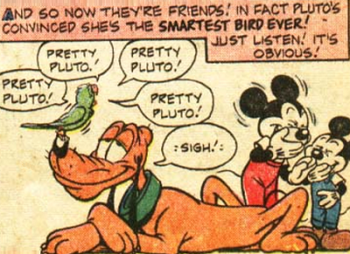
A parakeet owned by Mickey.
- Faking the Dead: She plays dead when Pluto fights the cat that attacked her. Pluto thinks she died from shock and tries to hide corpse until he knows how to break the news to his owners. He does so in his mouth, making it seem for a seond like he can talk when Binky gets up at the sound of her owners' voices.
- Fire-Forged Friends: Pluto stops objecting to Binky's addition to the household after saving her from a cat (that she nearly got eaten by because Pluto let her out of the house in the first place). Binky changing her main line to "Pretty Pluto!" thereafter also helps.
- Horrible Judge of Character: After Pluto makes her escape from her cage, the first creature she tries to make friends with is an obviously hungry cat.
- Polly Wants a Microphone: Binky learns to say two lines through the course of her one comic and repeats them constantly: "I'm Binky!" and "Pretty Pluto!".
Elsie the Elephant

- Canine Companion: Pluto is hers. The title of her debut comic even is a pun on "A Man's Best Friend Is His Dog", which ignores that Elsie's a her.
- Elephant in the Living Room: A literal case when Pluto tries to hide Elsie inside the house to prevent her being sent back to the zoo. The final hiding place is under Mickey's bed, which takes him a good while to realize. Needless to say, the zoo staff doesn't immediately believe him when he calls to tell he's found the missing elephant.
- Gentle Giant: From a dog's perspective. She's a sweet elephant who only wants Pluto to visit her again. He's elated when she comes looking for him, but not above turning her strength against Butch for stealing his bones.
- Interspecies Friendship: Elsie is an elephant and Pluto a dog, but they are very close. Overlaps with Old Friend by the time Elsie is old enough to escape the zoo and find Pluto. After the zoo staff realizes how much Pluto's visits mean to Elsie, they make an exception to the "No Dogs Allowed" rule so he can drop by any time.
- Orphan's Ordeal: Elsie's technically not an orphan, but she was separated from her mother at a young age to be raised in another zoo. On her first night alone, she couldn't stop crying and Pluto, at the zoo to taunt the big cats, came to keep her company. It meant the world to Elsie. Even when she got bigger and Pluto stayed away longer because he wasn't needed anymore, she still pined for her friend and eventually broke out to find him.
Marty and Milty
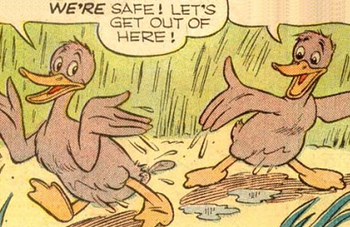
Two ducks Pluto hunted for, then befriended.
- Androcles' Lion: Despite being ordered to hunt them, Pluto saves the two ducks from drowning in quicksand with no intent to capture them in their vulnerable state. When he gets stuck himself, they return the favor.
- Karmic Trickster: After Marty gets shot and Pluto is to fetch him, he teams up with Milty to pull a Totem Pole Trench-type monster disguise with the aid of a hollow log. It backfires when they get stuck in quicksand, but Pluto saves them, only to end up stuck himself. Leads to a minor What the Hell, Hero? situation when Marty wants to leave Pluto to drown while Milty points out they can't do that.
- Team Spirit: Marty and Milty aren't strong enough to get Pluto back to shore, so they get their friends to pull the duck equivalent of a Balloonacy-enabled rescue.
Milo the Mule
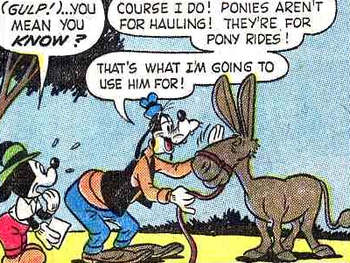
A mule Mickey bought for Goofy after he repeatedly failed to win a pony in contests.
- All Girls Like Ponies: Goofy may not be a girl, but the trope is in full effect due to his sheer obsession in the first few pages with winning himself a pony. Mickey arranges for Milo to be given to him disguised as a contest prize to avoid Goofy further misery.
- Fire-Forged Friends: Goofy wants nothing to do with Milo once he learns he's a mule and not a pony and takes him to Bigg City to trade him for the pony he thinks he's owed. However, Milo's identity as a horse shines through when he joins the other horses on the bridle paths in the park. He gets shooed away, prompting Goofy to gain a little sympathy and understanding for his pet. Some difficulties later, Milo spots a horse race going on in a nearby stadium and makes a beeline to participate, dragging Goofy along. They finish first, but only because Milo cut in at the last fifty feet. The organization, jockeys, and audience are mad about the intrusion, which causes Goofy to jump to Milo's defense. Fortunately, the press loves the underdog concept of a mule striving to compete with horses and the mood in the stadium changes in favor of Milo. After all this, Goofy decides Milo is a fine fit for him.
- Mix-and-Match Critters: Mentally rather than physical. Milo is a miniature mule who thinks he's a horse and who for a while was thought to be a pony by Goofy.
